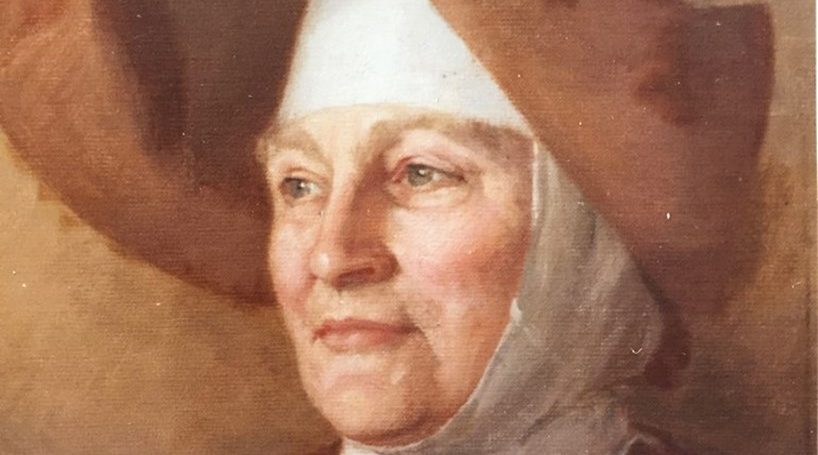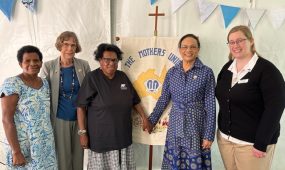Mother Teresa FSJM: from wild adolescent to unconventional Sister
News
When Mother Teresa of the Franciscan Servants of Jesus and Mary (FSJM) founded her order in 1926, she became part of a remarkable body of Anglican women religious founders. What distinguishes Mother Teresa from the others, however, is her unconventional backstory

When Mother Teresa of the Franciscan Servants of Jesus and Mary (FSJM) founded her order in 1926, she became part of that remarkable body of Anglican women religious founders that begins with Priscilla Lydia Sellon in 1848. What distinguishes Mother Teresa from the others, however, is her unconventional backstory. This is described in detail in a candid memoir that came to light when the FSJM closed in 2019.
Mother Teresa, born Grace Costin, was the daughter of a bigamous marriage. After an unhappy childhood and a “wild and completely pagan” adolescence, she left home as soon as she was able, to train as a nurse. In Holy Week, 1909, driven by an impulse that she could not explain, she began to attend the services at her local church in Hastings, and, “under an entirely unemotional compulsion”, asked the visiting friar to hear her confession. This led to what she later described as a “conversion”.
Forced to abandon her nursing training because of the worsening of a heart condition that she had suffered since childhood, she began to search for a role compatible with her new Christian belief and strongly held social principles: “All my interest and compassion was with those who rebelled against and broke the law.”
Her journey took her to a pioneering colony for women inebriates in Duxhurst, Surrey, and the United States, where she briefly stayed with the Sisters of the Order of St Anne, in Boston, before concluding: “The last thing in the world that I wanted was to be a Sister.”
She then took a series of temporary jobs in the US, before experiencing a change of heart: “I began to think anxiously about religious vocation, a subject that, in spite of my dislike and fear of it, was continually coming up as a question mark.”
On returning to England in autumn 1916, she felt that joining an enclosed community was not the right course of action while her country was at war. As a committed pacifist, Costin decided that she could best contribute to the war effort by joining the Women’s Police Service, but she soon began to question the “justice and rightness” of the law that she was required to uphold.
Advertisement
After the war, she finally joined the Sisters of the Order of St Anne, who now had a small community at Duxhurst. In August 1919, she took the habit and the name Sister Teresa.
The new Sister Teresa found herself “continually bumping up against the disconcerting fact that my reactions to most things were quite different to those of the rest of the Community”, and left after just a year. Fortunately, the charismatic priest of St Hilary, the Rev’d Bernard Walke, offered her work running a children’s home in his Cornish parish.
A great friendship developed, but Walke was sceptical of her continuing to question whether she had a vocation: “Anyone less suited to a life of prayer than myself he had never met!” After experiencing a persistent calling to form a new type of community, who would “live without fear, and without setting up the defences against other people with which religious communities safeguard the lives of their members”, and after “a vision of light”, she resigned from her job in 1926 to test her vocation.
Advertisement
For the next nine years, Sister Teresa pursued her dream of creating a religious order that lived not in a convent, but as part of the community. She frequently encountered opposition from those whose views differed from her own. Undeterred, she remained true to her vision, pursing a life of obedience to God — if not to parish priests or wardens.
These disputes necessitated the periodic moving of her nascent community from Cornwall, to Scotland, back to Cornwall, and then to City Road, in London. Meanwhile, she attracted a number of women to join in her difficult life of poverty, religious observance, and social work. These unusual women, who did not conform to either the religious or social mores of the time, were met with equal measures of appreciation and suspicion wherever they went.
By the time they left London, in 1937, prompted by another dispute with their vicar and warden, the FSJM had evolved into a recognisable community: they wore a distinctive brown habit; Mother Teresa and the most senior Sister, Margaret, a former concert pianist, had received their life vows; and among the other women testing their vocation were Sister Bernadine, a widowed draughtswoman, and Sister Faith, whose husband and child had both died tragically.
Their new home at Whitwell, on the Isle of Wight, at first appeared idyllic. Mother Ivy, an anchoress who had been Teresa’s mentor ever since her days at Duxhurst, lived in the village; they had a house large enough to host retreats, and a garden for growing vegetables.
Mother Teresa recalled: “it was here that we began to live the country life that has now become the fixed pattern of our labour for our support.” The small community took part in missions, prison visiting, school assemblies, and other social work, and Mother Teresa began to write regular newsletters as a way of maintaining contact with the 26 Externs who were by now affiliated to the community.
The holding of retreats was an important part of the FSJM’s ministry, and the travel restrictions on the island after the outbreak of the Second World War, coupled with Mother Teresa’s worsening health (she was now suffering from rheumatism, in addition to her heart issues), led them to contemplate another move, consolidated by a dispute with the vicar.
In keeping with the idiosyncracy of the community, Mother Teresa found their final, permanent home — “A typical thatched Devon farmhouse” — in the personal ads of The Daily Telegraph. On her first visit to Posbury, Mother Teresa was utterly captivated, and could immediately see the potential of the picture-book house with its elegant veranda and ornamental garden, set in the heart of the rolling mid-Devon countryside.
In February 1942, undeterred by the poor state of the garden and house, the community moved in. Finally, at Posbury St Francis, as it became known, 20 years after her calling at St Hilary, Mother Teresa was able to realise her dream: a community, not a convent, with Sisters, not nuns, and a Mother, but not a Mother Superior.
With minimal assistance, the Sisters set about converting the stables into a chapel, clearing the grounds, and refurbishing the house. By the summer, they were able to host the diocese of Exeter’s ordination retreat, whose previous venue had been destroyed during the Exeter Blitz. They continued to do so for more than 30 years.
The Sisters further developed their ministry with mission work, prison visiting, visiting the sick, and a Sunday school. Before the war was over, they were joined by 17-year-old Dorothy Inskip — who later, as Mother Hilary, was to succeed Mother Teresa — and a young horticulturist, Sister Mary, who transformed the overgrown grounds and created a market garden so productive that the Sisters were, in effect, self-sufficient.
Over the years, the special character of Posbury developed as the beautiful gardens matured, and ducks, hens, bees, pigs, dogs, and numerous cats, or the “lesser brethren” as they were called, joined the Sisters. Services in the summer took place at a garden altar, rescued after Mother Teresa found it abandoned in the churchyard at St Hilary.
By the 1950s, the Sisters had more than 1,000 visitors a year for their retreats and quiet days. They formed associations with several organisations, including the Anglican Pacifist Fellowship and the Mothers’ Union, for whom they hosted retreats and quiet days.
Help with the maintenance of the house and grounds, at times extremely arduous, came from two West Midlands parishes that sent working parties in the summer, from university students, and from the loyal company of Externs. A friendship with the creator of the Minack Theatre, Rowena Cade, led to her donating a chalet in Porthcurno for the Sisters, where they went to rest and recuperate.
Of the women who tried their vocation, four more Sisters — Bride, Elizabeth, Agnes, and Giovanna — became full members of the community. Sister Agnes eventually left to found her own order in the Shetlands.
Posbury remained true to Mother Teresa’s vision of a different type of community until her death in 1979, during which time stories of tractor-driving nuns and the idyllic landscape garden had brought attention not just locally, but nationally. Visitors by now included Bishop Trevor Huddleston, Sir Harry Secombe, and several BBC television crews.
After Mother Teresa’s death, as fewer women felt called to the religious life, the FSJM began a slow decline. After the death of Mother Hilary in February 2019, as there was only one surviving sister at Posbury, Sister Giovanna, the community came to an end. After the sale of the main house and other assets, the Posbury St Francis Trust (PSFT) was formed, with the objectives of continuing the FSJM’s work in mission, evangelism, and spirituality.
In its heyday, Mother Teresa was proud to state that she had created “a place of peace and joy, in which the veil between this world and the new earth which is promised to us, may be transparent enough to reveal in the eyes of all who come, something of the immortal loveliness of that country which is our true home.”
Bridget Gillard is writing a book on the life of Mother Teresa and her community. To receive further details of this publication when it is published, please contact admin@psft.org.uk.
First published in Church Times on 30 September 2022.





